Business Law Report: Structure, Obligations, and Dispute Resolution
VerifiedAdded on 2020/07/23
|10
|3257
|60
Report
AI Summary
This business law report provides a comprehensive overview of the English legal system, including its structure, sources of law (statutes, common law, and EU law), and the role of government in law-making. It delves into employer legal obligations, such as occupational health and safety, workers' compensation, harassment prevention, and equal opportunities, examining their impact through relevant employment and contract law. The report analyzes case studies, offering legal solutions for business problems, supported by relevant statutes and case precedents. Furthermore, it explores the concept and benefits of Alternative Dispute Resolution (ADR) processes and suggests alternative legal solutions to business problems. The report's content includes sections on the structure of the English legal system, employer obligations, and alternative dispute resolution, all supported by relevant legal frameworks and case studies, culminating in a conclusion and references.
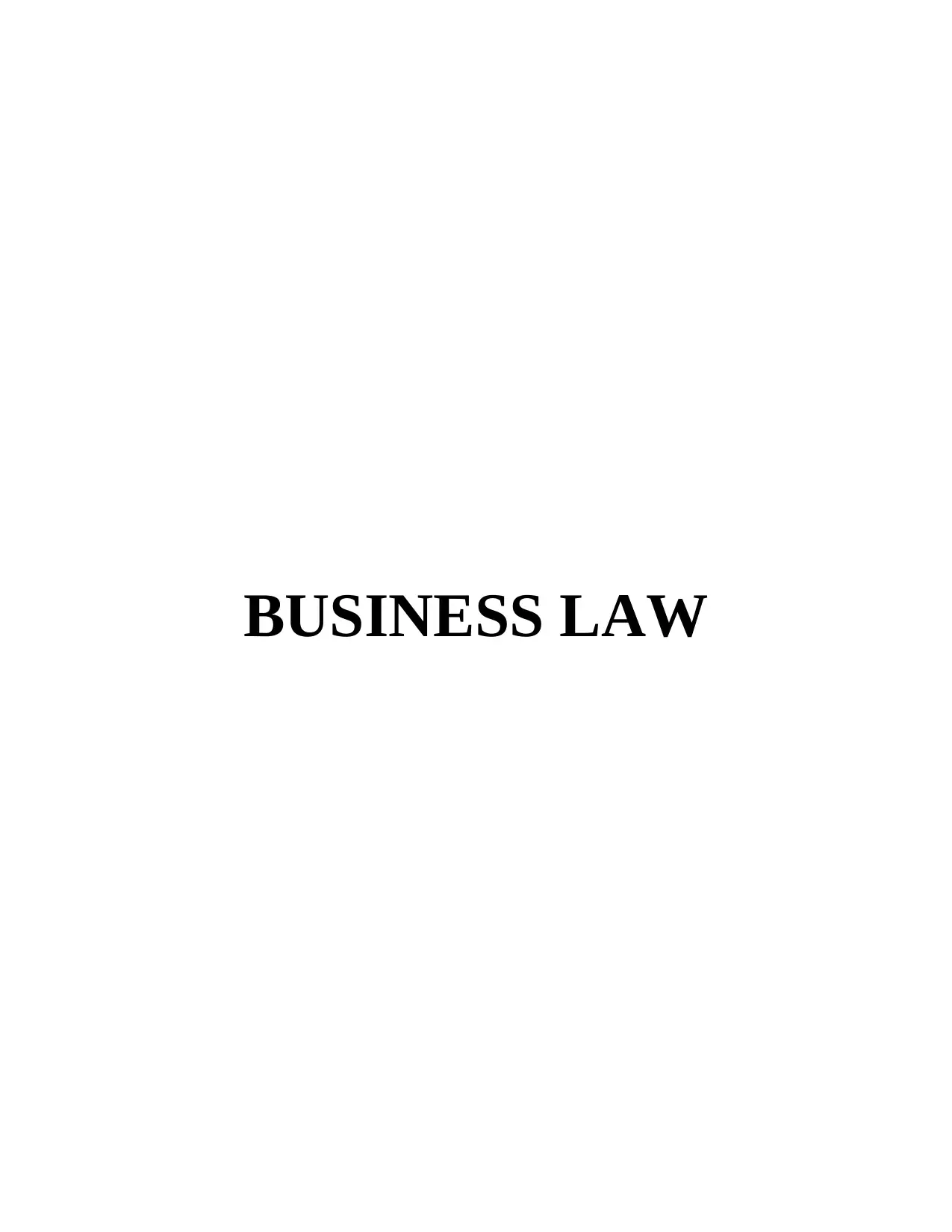
BUSINESS LAW
Paraphrase This Document
Need a fresh take? Get an instant paraphrase of this document with our AI Paraphraser
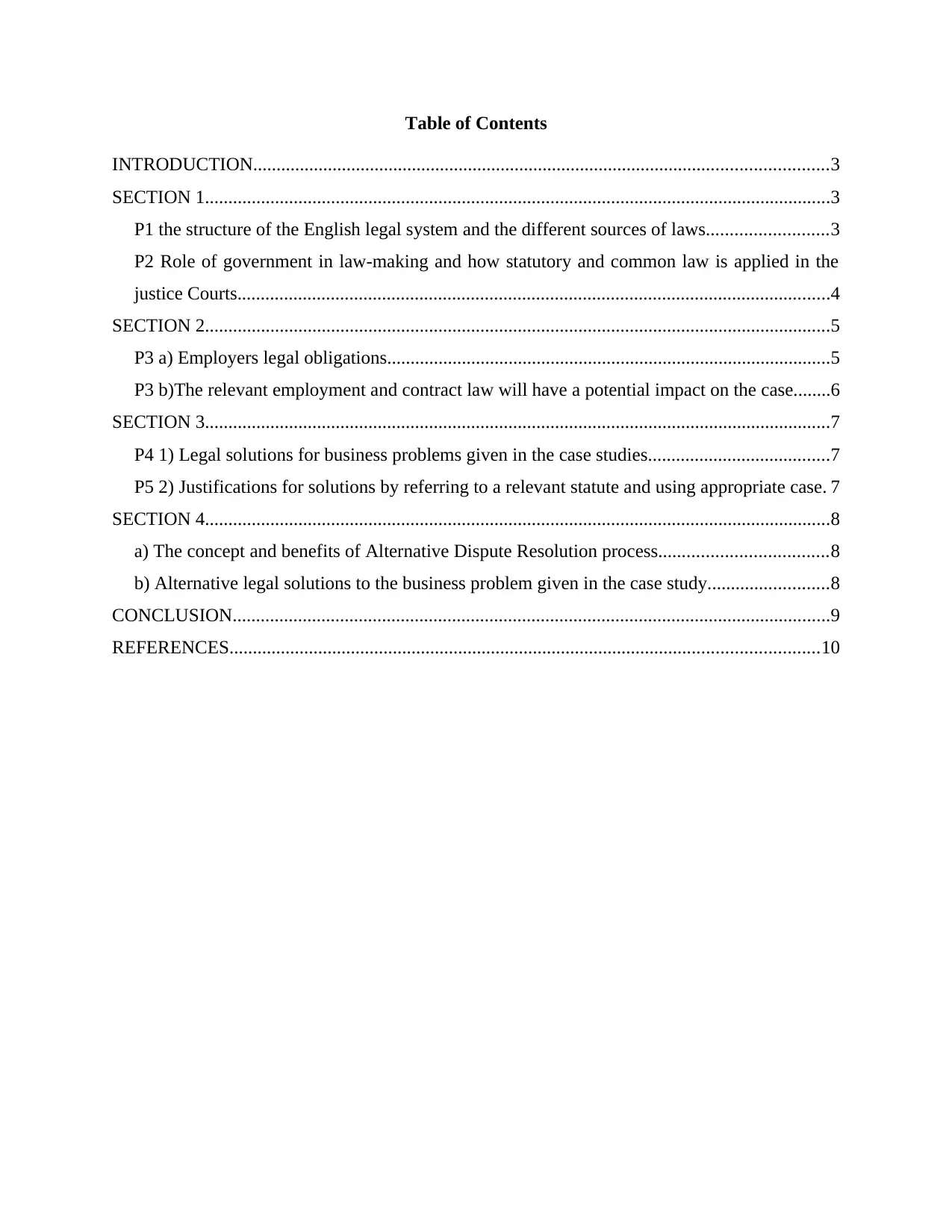
Table of Contents
INTRODUCTION...........................................................................................................................3
SECTION 1......................................................................................................................................3
P1 the structure of the English legal system and the different sources of laws..........................3
P2 Role of government in law-making and how statutory and common law is applied in the
justice Courts...............................................................................................................................4
SECTION 2......................................................................................................................................5
P3 a) Employers legal obligations...............................................................................................5
P3 b)The relevant employment and contract law will have a potential impact on the case........6
SECTION 3......................................................................................................................................7
P4 1) Legal solutions for business problems given in the case studies.......................................7
P5 2) Justifications for solutions by referring to a relevant statute and using appropriate case. 7
SECTION 4......................................................................................................................................8
a) The concept and benefits of Alternative Dispute Resolution process....................................8
b) Alternative legal solutions to the business problem given in the case study..........................8
CONCLUSION................................................................................................................................9
REFERENCES..............................................................................................................................10
INTRODUCTION...........................................................................................................................3
SECTION 1......................................................................................................................................3
P1 the structure of the English legal system and the different sources of laws..........................3
P2 Role of government in law-making and how statutory and common law is applied in the
justice Courts...............................................................................................................................4
SECTION 2......................................................................................................................................5
P3 a) Employers legal obligations...............................................................................................5
P3 b)The relevant employment and contract law will have a potential impact on the case........6
SECTION 3......................................................................................................................................7
P4 1) Legal solutions for business problems given in the case studies.......................................7
P5 2) Justifications for solutions by referring to a relevant statute and using appropriate case. 7
SECTION 4......................................................................................................................................8
a) The concept and benefits of Alternative Dispute Resolution process....................................8
b) Alternative legal solutions to the business problem given in the case study..........................8
CONCLUSION................................................................................................................................9
REFERENCES..............................................................................................................................10
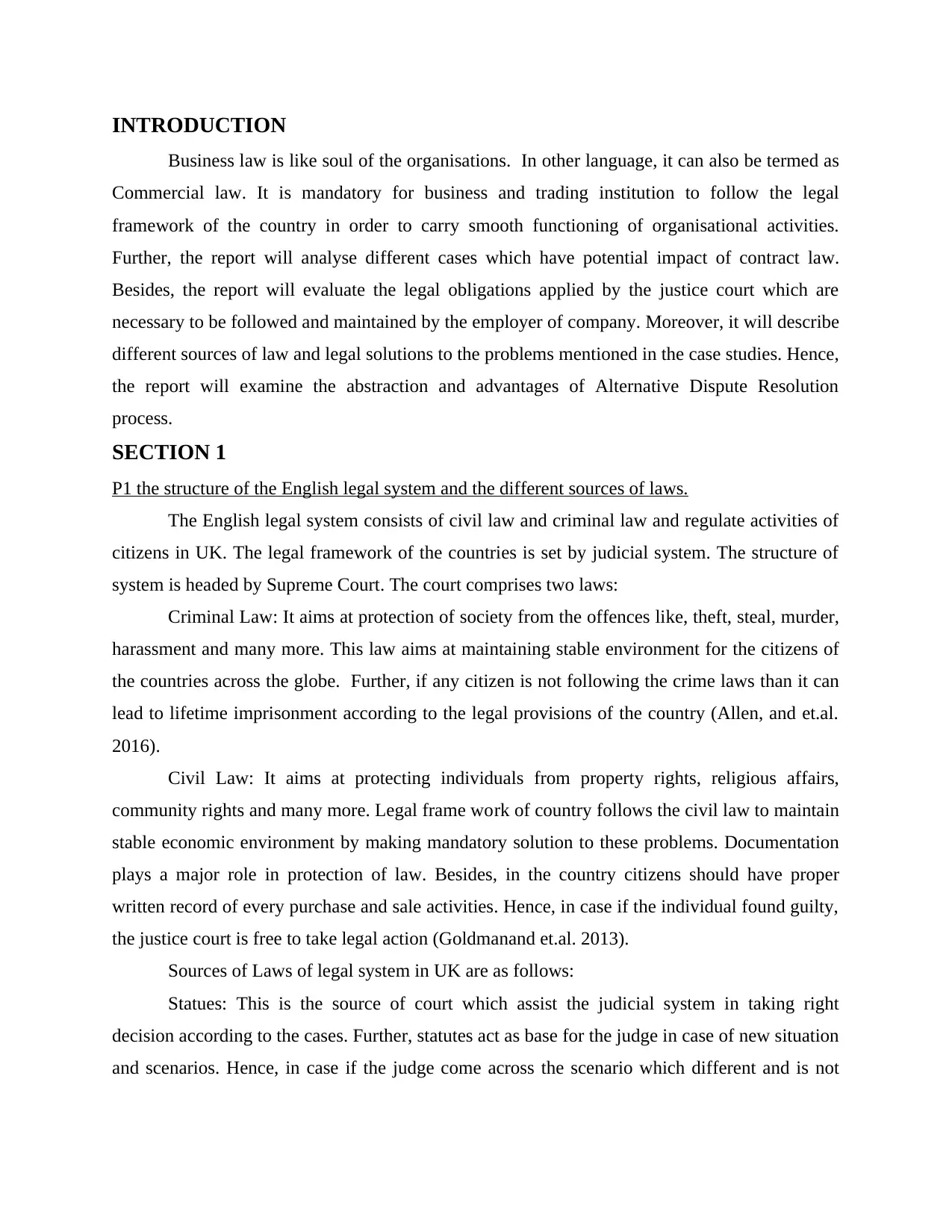
INTRODUCTION
Business law is like soul of the organisations. In other language, it can also be termed as
Commercial law. It is mandatory for business and trading institution to follow the legal
framework of the country in order to carry smooth functioning of organisational activities.
Further, the report will analyse different cases which have potential impact of contract law.
Besides, the report will evaluate the legal obligations applied by the justice court which are
necessary to be followed and maintained by the employer of company. Moreover, it will describe
different sources of law and legal solutions to the problems mentioned in the case studies. Hence,
the report will examine the abstraction and advantages of Alternative Dispute Resolution
process.
SECTION 1
P1 the structure of the English legal system and the different sources of laws.
The English legal system consists of civil law and criminal law and regulate activities of
citizens in UK. The legal framework of the countries is set by judicial system. The structure of
system is headed by Supreme Court. The court comprises two laws:
Criminal Law: It aims at protection of society from the offences like, theft, steal, murder,
harassment and many more. This law aims at maintaining stable environment for the citizens of
the countries across the globe. Further, if any citizen is not following the crime laws than it can
lead to lifetime imprisonment according to the legal provisions of the country (Allen, and et.al.
2016).
Civil Law: It aims at protecting individuals from property rights, religious affairs,
community rights and many more. Legal frame work of country follows the civil law to maintain
stable economic environment by making mandatory solution to these problems. Documentation
plays a major role in protection of law. Besides, in the country citizens should have proper
written record of every purchase and sale activities. Hence, in case if the individual found guilty,
the justice court is free to take legal action (Goldmanand et.al. 2013).
Sources of Laws of legal system in UK are as follows:
Statues: This is the source of court which assist the judicial system in taking right
decision according to the cases. Further, statutes act as base for the judge in case of new situation
and scenarios. Hence, in case if the judge come across the scenario which different and is not
Business law is like soul of the organisations. In other language, it can also be termed as
Commercial law. It is mandatory for business and trading institution to follow the legal
framework of the country in order to carry smooth functioning of organisational activities.
Further, the report will analyse different cases which have potential impact of contract law.
Besides, the report will evaluate the legal obligations applied by the justice court which are
necessary to be followed and maintained by the employer of company. Moreover, it will describe
different sources of law and legal solutions to the problems mentioned in the case studies. Hence,
the report will examine the abstraction and advantages of Alternative Dispute Resolution
process.
SECTION 1
P1 the structure of the English legal system and the different sources of laws.
The English legal system consists of civil law and criminal law and regulate activities of
citizens in UK. The legal framework of the countries is set by judicial system. The structure of
system is headed by Supreme Court. The court comprises two laws:
Criminal Law: It aims at protection of society from the offences like, theft, steal, murder,
harassment and many more. This law aims at maintaining stable environment for the citizens of
the countries across the globe. Further, if any citizen is not following the crime laws than it can
lead to lifetime imprisonment according to the legal provisions of the country (Allen, and et.al.
2016).
Civil Law: It aims at protecting individuals from property rights, religious affairs,
community rights and many more. Legal frame work of country follows the civil law to maintain
stable economic environment by making mandatory solution to these problems. Documentation
plays a major role in protection of law. Besides, in the country citizens should have proper
written record of every purchase and sale activities. Hence, in case if the individual found guilty,
the justice court is free to take legal action (Goldmanand et.al. 2013).
Sources of Laws of legal system in UK are as follows:
Statues: This is the source of court which assist the judicial system in taking right
decision according to the cases. Further, statutes act as base for the judge in case of new situation
and scenarios. Hence, in case if the judge come across the scenario which different and is not
⊘ This is a preview!⊘
Do you want full access?
Subscribe today to unlock all pages.

Trusted by 1+ million students worldwide
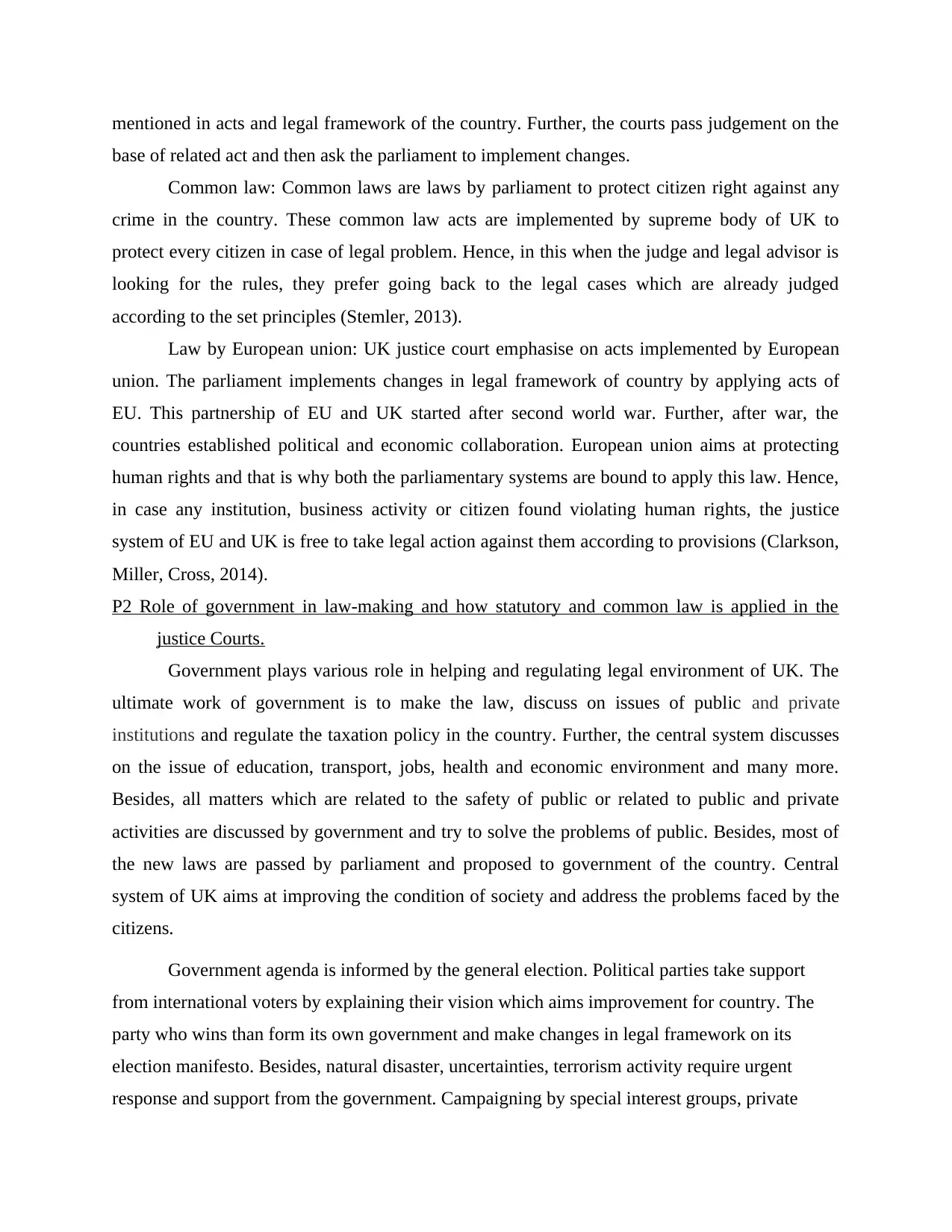
mentioned in acts and legal framework of the country. Further, the courts pass judgement on the
base of related act and then ask the parliament to implement changes.
Common law: Common laws are laws by parliament to protect citizen right against any
crime in the country. These common law acts are implemented by supreme body of UK to
protect every citizen in case of legal problem. Hence, in this when the judge and legal advisor is
looking for the rules, they prefer going back to the legal cases which are already judged
according to the set principles (Stemler, 2013).
Law by European union: UK justice court emphasise on acts implemented by European
union. The parliament implements changes in legal framework of country by applying acts of
EU. This partnership of EU and UK started after second world war. Further, after war, the
countries established political and economic collaboration. European union aims at protecting
human rights and that is why both the parliamentary systems are bound to apply this law. Hence,
in case any institution, business activity or citizen found violating human rights, the justice
system of EU and UK is free to take legal action against them according to provisions (Clarkson,
Miller, Cross, 2014).
P2 Role of government in law-making and how statutory and common law is applied in the
justice Courts.
Government plays various role in helping and regulating legal environment of UK. The
ultimate work of government is to make the law, discuss on issues of public and private
institutions and regulate the taxation policy in the country. Further, the central system discusses
on the issue of education, transport, jobs, health and economic environment and many more.
Besides, all matters which are related to the safety of public or related to public and private
activities are discussed by government and try to solve the problems of public. Besides, most of
the new laws are passed by parliament and proposed to government of the country. Central
system of UK aims at improving the condition of society and address the problems faced by the
citizens.
Government agenda is informed by the general election. Political parties take support
from international voters by explaining their vision which aims improvement for country. The
party who wins than form its own government and make changes in legal framework on its
election manifesto. Besides, natural disaster, uncertainties, terrorism activity require urgent
response and support from the government. Campaigning by special interest groups, private
base of related act and then ask the parliament to implement changes.
Common law: Common laws are laws by parliament to protect citizen right against any
crime in the country. These common law acts are implemented by supreme body of UK to
protect every citizen in case of legal problem. Hence, in this when the judge and legal advisor is
looking for the rules, they prefer going back to the legal cases which are already judged
according to the set principles (Stemler, 2013).
Law by European union: UK justice court emphasise on acts implemented by European
union. The parliament implements changes in legal framework of country by applying acts of
EU. This partnership of EU and UK started after second world war. Further, after war, the
countries established political and economic collaboration. European union aims at protecting
human rights and that is why both the parliamentary systems are bound to apply this law. Hence,
in case any institution, business activity or citizen found violating human rights, the justice
system of EU and UK is free to take legal action against them according to provisions (Clarkson,
Miller, Cross, 2014).
P2 Role of government in law-making and how statutory and common law is applied in the
justice Courts.
Government plays various role in helping and regulating legal environment of UK. The
ultimate work of government is to make the law, discuss on issues of public and private
institutions and regulate the taxation policy in the country. Further, the central system discusses
on the issue of education, transport, jobs, health and economic environment and many more.
Besides, all matters which are related to the safety of public or related to public and private
activities are discussed by government and try to solve the problems of public. Besides, most of
the new laws are passed by parliament and proposed to government of the country. Central
system of UK aims at improving the condition of society and address the problems faced by the
citizens.
Government agenda is informed by the general election. Political parties take support
from international voters by explaining their vision which aims improvement for country. The
party who wins than form its own government and make changes in legal framework on its
election manifesto. Besides, natural disaster, uncertainties, terrorism activity require urgent
response and support from the government. Campaigning by special interest groups, private
Paraphrase This Document
Need a fresh take? Get an instant paraphrase of this document with our AI Paraphraser
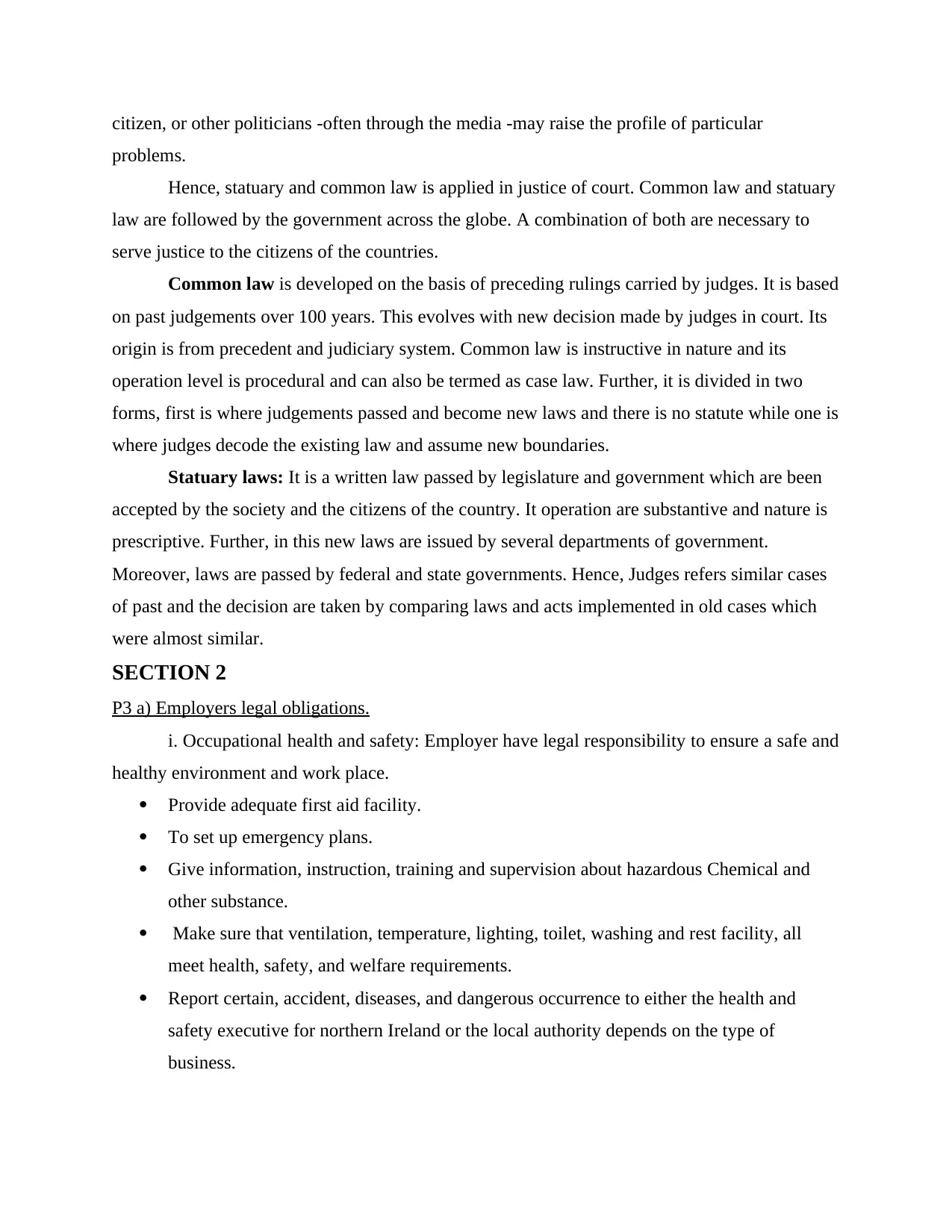
citizen, or other politicians -often through the media -may raise the profile of particular
problems.
Hence, statuary and common law is applied in justice of court. Common law and statuary
law are followed by the government across the globe. A combination of both are necessary to
serve justice to the citizens of the countries.
Common law is developed on the basis of preceding rulings carried by judges. It is based
on past judgements over 100 years. This evolves with new decision made by judges in court. Its
origin is from precedent and judiciary system. Common law is instructive in nature and its
operation level is procedural and can also be termed as case law. Further, it is divided in two
forms, first is where judgements passed and become new laws and there is no statute while one is
where judges decode the existing law and assume new boundaries.
Statuary laws: It is a written law passed by legislature and government which are been
accepted by the society and the citizens of the country. It operation are substantive and nature is
prescriptive. Further, in this new laws are issued by several departments of government.
Moreover, laws are passed by federal and state governments. Hence, Judges refers similar cases
of past and the decision are taken by comparing laws and acts implemented in old cases which
were almost similar.
SECTION 2
P3 a) Employers legal obligations.
i. Occupational health and safety: Employer have legal responsibility to ensure a safe and
healthy environment and work place.
Provide adequate first aid facility.
To set up emergency plans.
Give information, instruction, training and supervision about hazardous Chemical and
other substance.
Make sure that ventilation, temperature, lighting, toilet, washing and rest facility, all
meet health, safety, and welfare requirements.
Report certain, accident, diseases, and dangerous occurrence to either the health and
safety executive for northern Ireland or the local authority depends on the type of
business.
problems.
Hence, statuary and common law is applied in justice of court. Common law and statuary
law are followed by the government across the globe. A combination of both are necessary to
serve justice to the citizens of the countries.
Common law is developed on the basis of preceding rulings carried by judges. It is based
on past judgements over 100 years. This evolves with new decision made by judges in court. Its
origin is from precedent and judiciary system. Common law is instructive in nature and its
operation level is procedural and can also be termed as case law. Further, it is divided in two
forms, first is where judgements passed and become new laws and there is no statute while one is
where judges decode the existing law and assume new boundaries.
Statuary laws: It is a written law passed by legislature and government which are been
accepted by the society and the citizens of the country. It operation are substantive and nature is
prescriptive. Further, in this new laws are issued by several departments of government.
Moreover, laws are passed by federal and state governments. Hence, Judges refers similar cases
of past and the decision are taken by comparing laws and acts implemented in old cases which
were almost similar.
SECTION 2
P3 a) Employers legal obligations.
i. Occupational health and safety: Employer have legal responsibility to ensure a safe and
healthy environment and work place.
Provide adequate first aid facility.
To set up emergency plans.
Give information, instruction, training and supervision about hazardous Chemical and
other substance.
Make sure that ventilation, temperature, lighting, toilet, washing and rest facility, all
meet health, safety, and welfare requirements.
Report certain, accident, diseases, and dangerous occurrence to either the health and
safety executive for northern Ireland or the local authority depends on the type of
business.
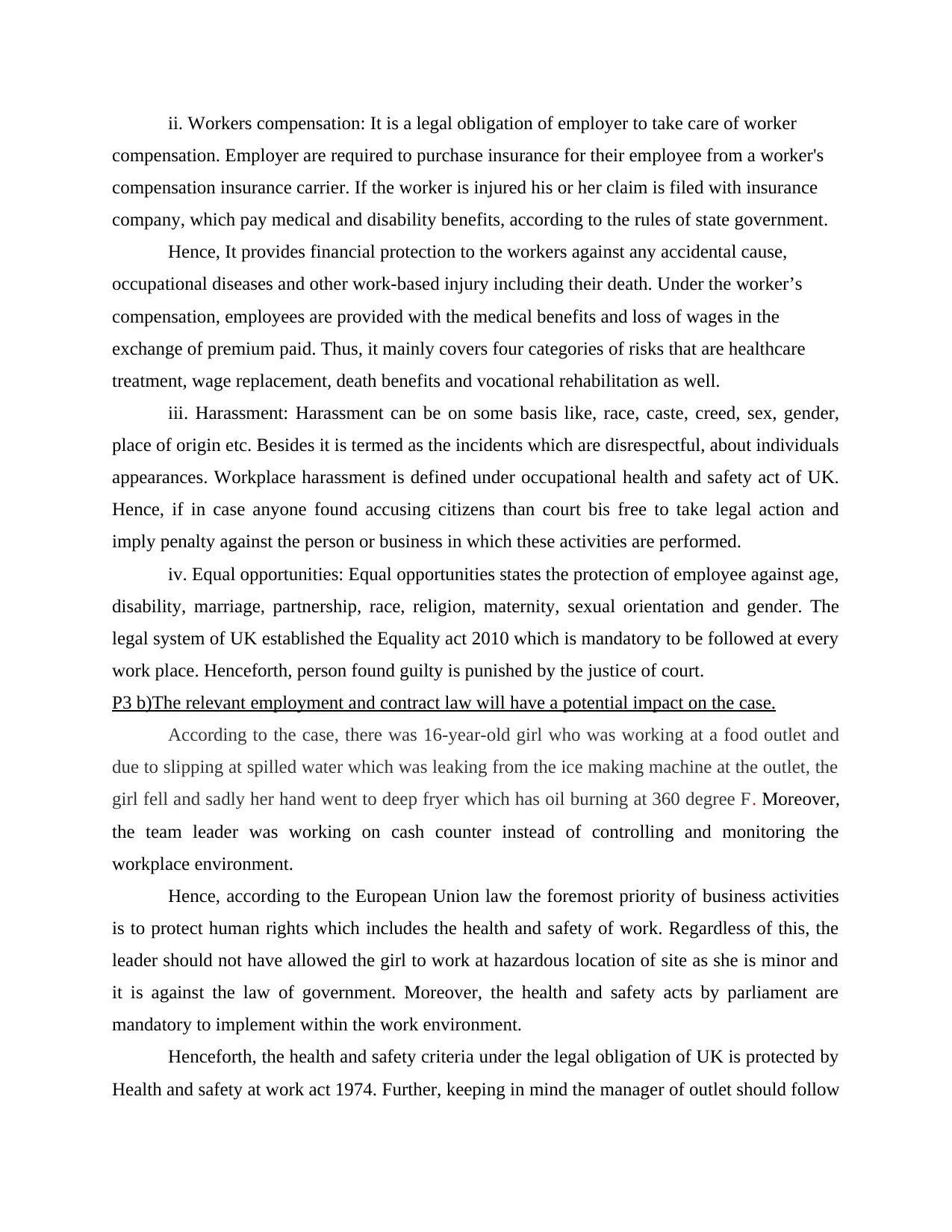
ii. Workers compensation: It is a legal obligation of employer to take care of worker
compensation. Employer are required to purchase insurance for their employee from a worker's
compensation insurance carrier. If the worker is injured his or her claim is filed with insurance
company, which pay medical and disability benefits, according to the rules of state government.
Hence, It provides financial protection to the workers against any accidental cause,
occupational diseases and other work-based injury including their death. Under the worker’s
compensation, employees are provided with the medical benefits and loss of wages in the
exchange of premium paid. Thus, it mainly covers four categories of risks that are healthcare
treatment, wage replacement, death benefits and vocational rehabilitation as well.
iii. Harassment: Harassment can be on some basis like, race, caste, creed, sex, gender,
place of origin etc. Besides it is termed as the incidents which are disrespectful, about individuals
appearances. Workplace harassment is defined under occupational health and safety act of UK.
Hence, if in case anyone found accusing citizens than court bis free to take legal action and
imply penalty against the person or business in which these activities are performed.
iv. Equal opportunities: Equal opportunities states the protection of employee against age,
disability, marriage, partnership, race, religion, maternity, sexual orientation and gender. The
legal system of UK established the Equality act 2010 which is mandatory to be followed at every
work place. Henceforth, person found guilty is punished by the justice of court.
P3 b)The relevant employment and contract law will have a potential impact on the case.
According to the case, there was 16-year-old girl who was working at a food outlet and
due to slipping at spilled water which was leaking from the ice making machine at the outlet, the
girl fell and sadly her hand went to deep fryer which has oil burning at 360 degree F. Moreover,
the team leader was working on cash counter instead of controlling and monitoring the
workplace environment.
Hence, according to the European Union law the foremost priority of business activities
is to protect human rights which includes the health and safety of work. Regardless of this, the
leader should not have allowed the girl to work at hazardous location of site as she is minor and
it is against the law of government. Moreover, the health and safety acts by parliament are
mandatory to implement within the work environment.
Henceforth, the health and safety criteria under the legal obligation of UK is protected by
Health and safety at work act 1974. Further, keeping in mind the manager of outlet should follow
compensation. Employer are required to purchase insurance for their employee from a worker's
compensation insurance carrier. If the worker is injured his or her claim is filed with insurance
company, which pay medical and disability benefits, according to the rules of state government.
Hence, It provides financial protection to the workers against any accidental cause,
occupational diseases and other work-based injury including their death. Under the worker’s
compensation, employees are provided with the medical benefits and loss of wages in the
exchange of premium paid. Thus, it mainly covers four categories of risks that are healthcare
treatment, wage replacement, death benefits and vocational rehabilitation as well.
iii. Harassment: Harassment can be on some basis like, race, caste, creed, sex, gender,
place of origin etc. Besides it is termed as the incidents which are disrespectful, about individuals
appearances. Workplace harassment is defined under occupational health and safety act of UK.
Hence, if in case anyone found accusing citizens than court bis free to take legal action and
imply penalty against the person or business in which these activities are performed.
iv. Equal opportunities: Equal opportunities states the protection of employee against age,
disability, marriage, partnership, race, religion, maternity, sexual orientation and gender. The
legal system of UK established the Equality act 2010 which is mandatory to be followed at every
work place. Henceforth, person found guilty is punished by the justice of court.
P3 b)The relevant employment and contract law will have a potential impact on the case.
According to the case, there was 16-year-old girl who was working at a food outlet and
due to slipping at spilled water which was leaking from the ice making machine at the outlet, the
girl fell and sadly her hand went to deep fryer which has oil burning at 360 degree F. Moreover,
the team leader was working on cash counter instead of controlling and monitoring the
workplace environment.
Hence, according to the European Union law the foremost priority of business activities
is to protect human rights which includes the health and safety of work. Regardless of this, the
leader should not have allowed the girl to work at hazardous location of site as she is minor and
it is against the law of government. Moreover, the health and safety acts by parliament are
mandatory to implement within the work environment.
Henceforth, the health and safety criteria under the legal obligation of UK is protected by
Health and safety at work act 1974. Further, keeping in mind the manager of outlet should follow
⊘ This is a preview!⊘
Do you want full access?
Subscribe today to unlock all pages.

Trusted by 1+ million students worldwide
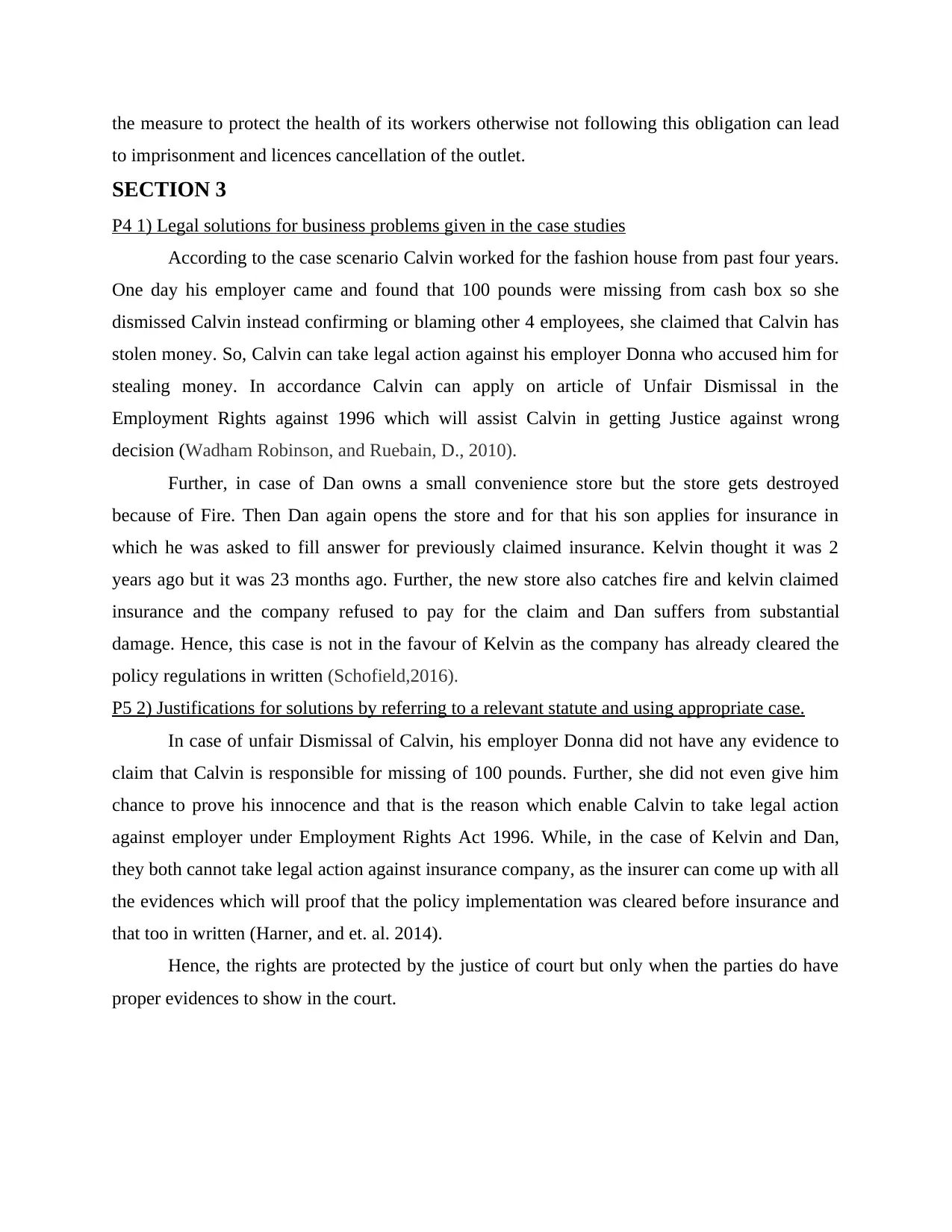
the measure to protect the health of its workers otherwise not following this obligation can lead
to imprisonment and licences cancellation of the outlet.
SECTION 3
P4 1) Legal solutions for business problems given in the case studies
According to the case scenario Calvin worked for the fashion house from past four years.
One day his employer came and found that 100 pounds were missing from cash box so she
dismissed Calvin instead confirming or blaming other 4 employees, she claimed that Calvin has
stolen money. So, Calvin can take legal action against his employer Donna who accused him for
stealing money. In accordance Calvin can apply on article of Unfair Dismissal in the
Employment Rights against 1996 which will assist Calvin in getting Justice against wrong
decision (Wadham Robinson, and Ruebain, D., 2010).
Further, in case of Dan owns a small convenience store but the store gets destroyed
because of Fire. Then Dan again opens the store and for that his son applies for insurance in
which he was asked to fill answer for previously claimed insurance. Kelvin thought it was 2
years ago but it was 23 months ago. Further, the new store also catches fire and kelvin claimed
insurance and the company refused to pay for the claim and Dan suffers from substantial
damage. Hence, this case is not in the favour of Kelvin as the company has already cleared the
policy regulations in written (Schofield,2016).
P5 2) Justifications for solutions by referring to a relevant statute and using appropriate case.
In case of unfair Dismissal of Calvin, his employer Donna did not have any evidence to
claim that Calvin is responsible for missing of 100 pounds. Further, she did not even give him
chance to prove his innocence and that is the reason which enable Calvin to take legal action
against employer under Employment Rights Act 1996. While, in the case of Kelvin and Dan,
they both cannot take legal action against insurance company, as the insurer can come up with all
the evidences which will proof that the policy implementation was cleared before insurance and
that too in written (Harner, and et. al. 2014).
Hence, the rights are protected by the justice of court but only when the parties do have
proper evidences to show in the court.
to imprisonment and licences cancellation of the outlet.
SECTION 3
P4 1) Legal solutions for business problems given in the case studies
According to the case scenario Calvin worked for the fashion house from past four years.
One day his employer came and found that 100 pounds were missing from cash box so she
dismissed Calvin instead confirming or blaming other 4 employees, she claimed that Calvin has
stolen money. So, Calvin can take legal action against his employer Donna who accused him for
stealing money. In accordance Calvin can apply on article of Unfair Dismissal in the
Employment Rights against 1996 which will assist Calvin in getting Justice against wrong
decision (Wadham Robinson, and Ruebain, D., 2010).
Further, in case of Dan owns a small convenience store but the store gets destroyed
because of Fire. Then Dan again opens the store and for that his son applies for insurance in
which he was asked to fill answer for previously claimed insurance. Kelvin thought it was 2
years ago but it was 23 months ago. Further, the new store also catches fire and kelvin claimed
insurance and the company refused to pay for the claim and Dan suffers from substantial
damage. Hence, this case is not in the favour of Kelvin as the company has already cleared the
policy regulations in written (Schofield,2016).
P5 2) Justifications for solutions by referring to a relevant statute and using appropriate case.
In case of unfair Dismissal of Calvin, his employer Donna did not have any evidence to
claim that Calvin is responsible for missing of 100 pounds. Further, she did not even give him
chance to prove his innocence and that is the reason which enable Calvin to take legal action
against employer under Employment Rights Act 1996. While, in the case of Kelvin and Dan,
they both cannot take legal action against insurance company, as the insurer can come up with all
the evidences which will proof that the policy implementation was cleared before insurance and
that too in written (Harner, and et. al. 2014).
Hence, the rights are protected by the justice of court but only when the parties do have
proper evidences to show in the court.
Paraphrase This Document
Need a fresh take? Get an instant paraphrase of this document with our AI Paraphraser
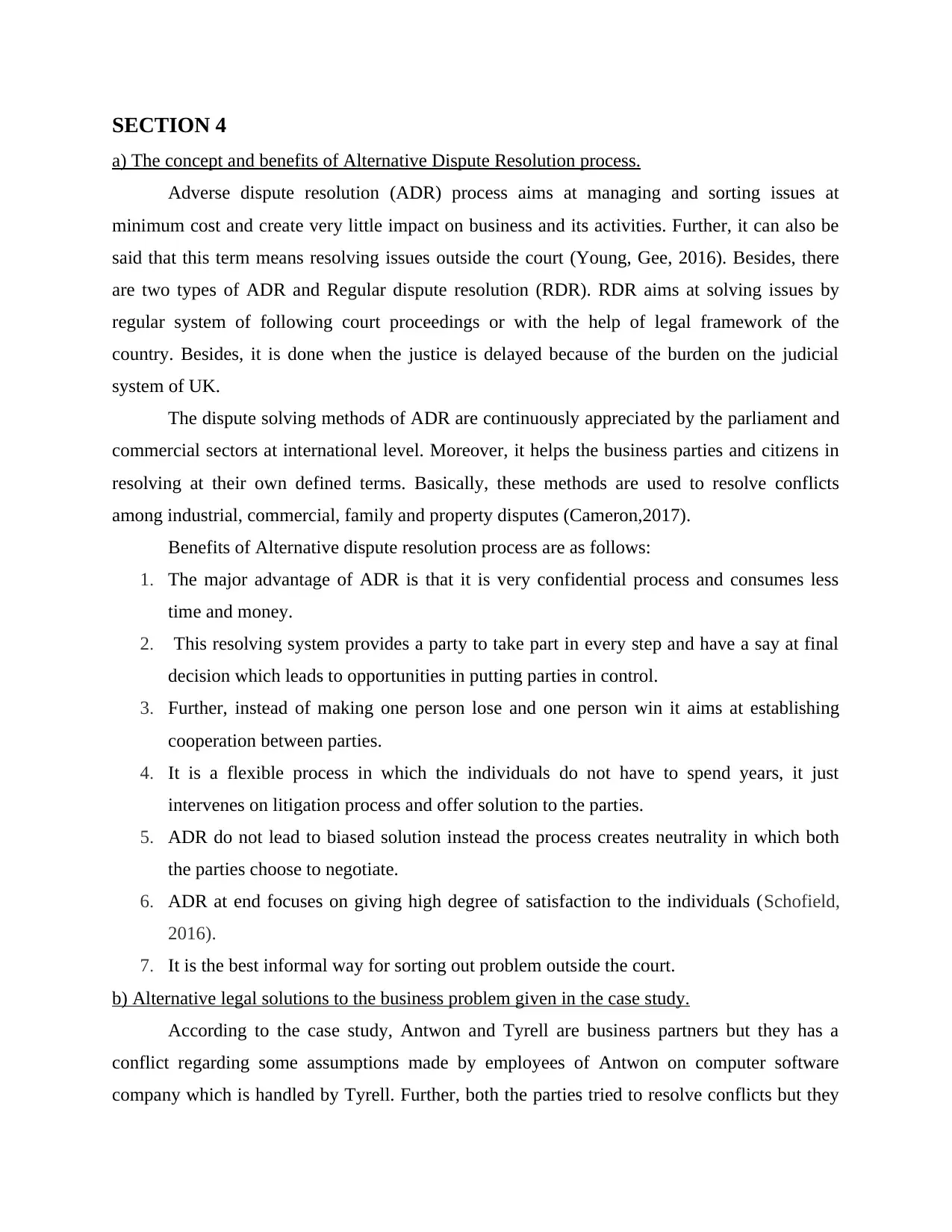
SECTION 4
a) The concept and benefits of Alternative Dispute Resolution process.
Adverse dispute resolution (ADR) process aims at managing and sorting issues at
minimum cost and create very little impact on business and its activities. Further, it can also be
said that this term means resolving issues outside the court (Young, Gee, 2016). Besides, there
are two types of ADR and Regular dispute resolution (RDR). RDR aims at solving issues by
regular system of following court proceedings or with the help of legal framework of the
country. Besides, it is done when the justice is delayed because of the burden on the judicial
system of UK.
The dispute solving methods of ADR are continuously appreciated by the parliament and
commercial sectors at international level. Moreover, it helps the business parties and citizens in
resolving at their own defined terms. Basically, these methods are used to resolve conflicts
among industrial, commercial, family and property disputes (Cameron,2017).
Benefits of Alternative dispute resolution process are as follows:
1. The major advantage of ADR is that it is very confidential process and consumes less
time and money.
2. This resolving system provides a party to take part in every step and have a say at final
decision which leads to opportunities in putting parties in control.
3. Further, instead of making one person lose and one person win it aims at establishing
cooperation between parties.
4. It is a flexible process in which the individuals do not have to spend years, it just
intervenes on litigation process and offer solution to the parties.
5. ADR do not lead to biased solution instead the process creates neutrality in which both
the parties choose to negotiate.
6. ADR at end focuses on giving high degree of satisfaction to the individuals (Schofield,
2016).
7. It is the best informal way for sorting out problem outside the court.
b) Alternative legal solutions to the business problem given in the case study.
According to the case study, Antwon and Tyrell are business partners but they has a
conflict regarding some assumptions made by employees of Antwon on computer software
company which is handled by Tyrell. Further, both the parties tried to resolve conflicts but they
a) The concept and benefits of Alternative Dispute Resolution process.
Adverse dispute resolution (ADR) process aims at managing and sorting issues at
minimum cost and create very little impact on business and its activities. Further, it can also be
said that this term means resolving issues outside the court (Young, Gee, 2016). Besides, there
are two types of ADR and Regular dispute resolution (RDR). RDR aims at solving issues by
regular system of following court proceedings or with the help of legal framework of the
country. Besides, it is done when the justice is delayed because of the burden on the judicial
system of UK.
The dispute solving methods of ADR are continuously appreciated by the parliament and
commercial sectors at international level. Moreover, it helps the business parties and citizens in
resolving at their own defined terms. Basically, these methods are used to resolve conflicts
among industrial, commercial, family and property disputes (Cameron,2017).
Benefits of Alternative dispute resolution process are as follows:
1. The major advantage of ADR is that it is very confidential process and consumes less
time and money.
2. This resolving system provides a party to take part in every step and have a say at final
decision which leads to opportunities in putting parties in control.
3. Further, instead of making one person lose and one person win it aims at establishing
cooperation between parties.
4. It is a flexible process in which the individuals do not have to spend years, it just
intervenes on litigation process and offer solution to the parties.
5. ADR do not lead to biased solution instead the process creates neutrality in which both
the parties choose to negotiate.
6. ADR at end focuses on giving high degree of satisfaction to the individuals (Schofield,
2016).
7. It is the best informal way for sorting out problem outside the court.
b) Alternative legal solutions to the business problem given in the case study.
According to the case study, Antwon and Tyrell are business partners but they has a
conflict regarding some assumptions made by employees of Antwon on computer software
company which is handled by Tyrell. Further, both the parties tried to resolve conflicts but they
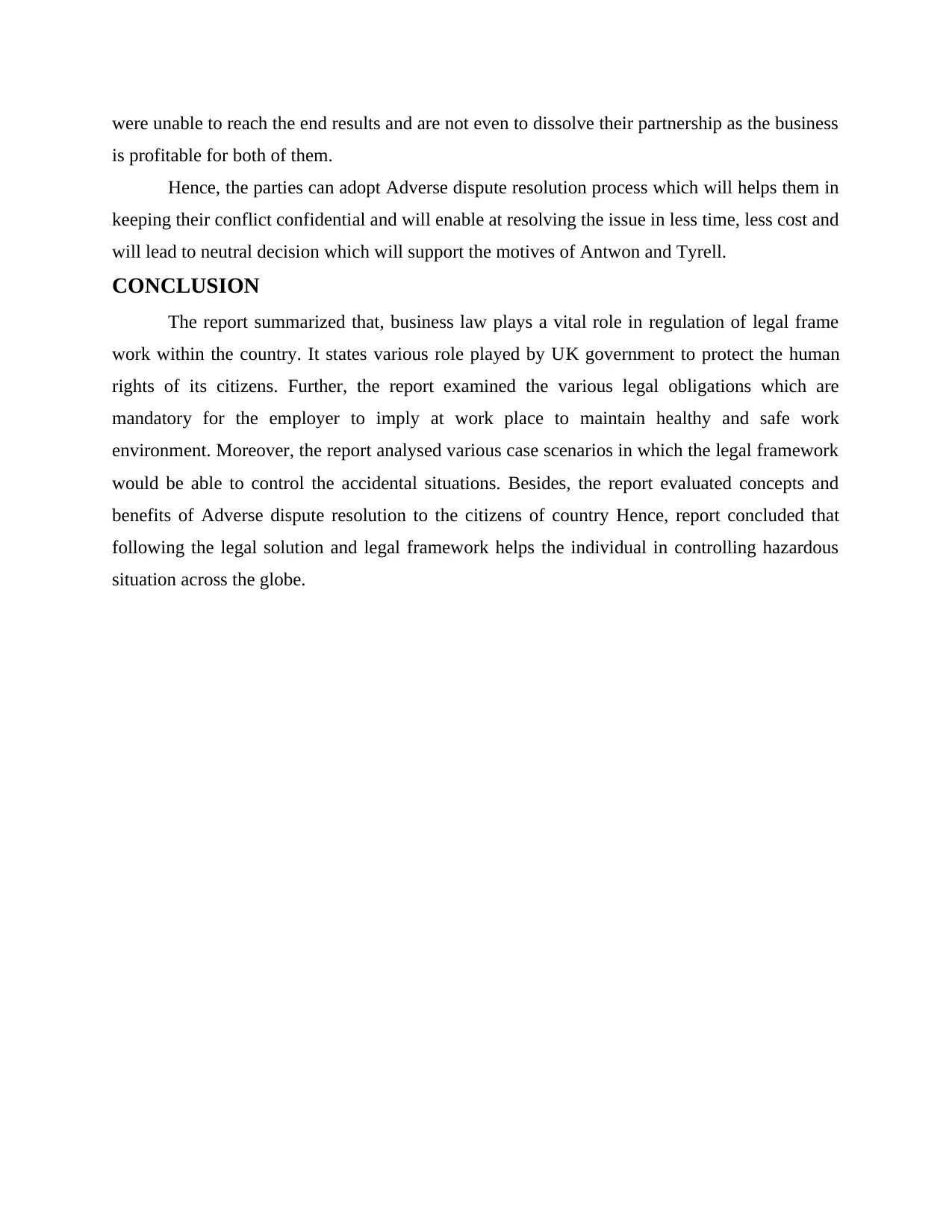
were unable to reach the end results and are not even to dissolve their partnership as the business
is profitable for both of them.
Hence, the parties can adopt Adverse dispute resolution process which will helps them in
keeping their conflict confidential and will enable at resolving the issue in less time, less cost and
will lead to neutral decision which will support the motives of Antwon and Tyrell.
CONCLUSION
The report summarized that, business law plays a vital role in regulation of legal frame
work within the country. It states various role played by UK government to protect the human
rights of its citizens. Further, the report examined the various legal obligations which are
mandatory for the employer to imply at work place to maintain healthy and safe work
environment. Moreover, the report analysed various case scenarios in which the legal framework
would be able to control the accidental situations. Besides, the report evaluated concepts and
benefits of Adverse dispute resolution to the citizens of country Hence, report concluded that
following the legal solution and legal framework helps the individual in controlling hazardous
situation across the globe.
is profitable for both of them.
Hence, the parties can adopt Adverse dispute resolution process which will helps them in
keeping their conflict confidential and will enable at resolving the issue in less time, less cost and
will lead to neutral decision which will support the motives of Antwon and Tyrell.
CONCLUSION
The report summarized that, business law plays a vital role in regulation of legal frame
work within the country. It states various role played by UK government to protect the human
rights of its citizens. Further, the report examined the various legal obligations which are
mandatory for the employer to imply at work place to maintain healthy and safe work
environment. Moreover, the report analysed various case scenarios in which the legal framework
would be able to control the accidental situations. Besides, the report evaluated concepts and
benefits of Adverse dispute resolution to the citizens of country Hence, report concluded that
following the legal solution and legal framework helps the individual in controlling hazardous
situation across the globe.
⊘ This is a preview!⊘
Do you want full access?
Subscribe today to unlock all pages.

Trusted by 1+ million students worldwide
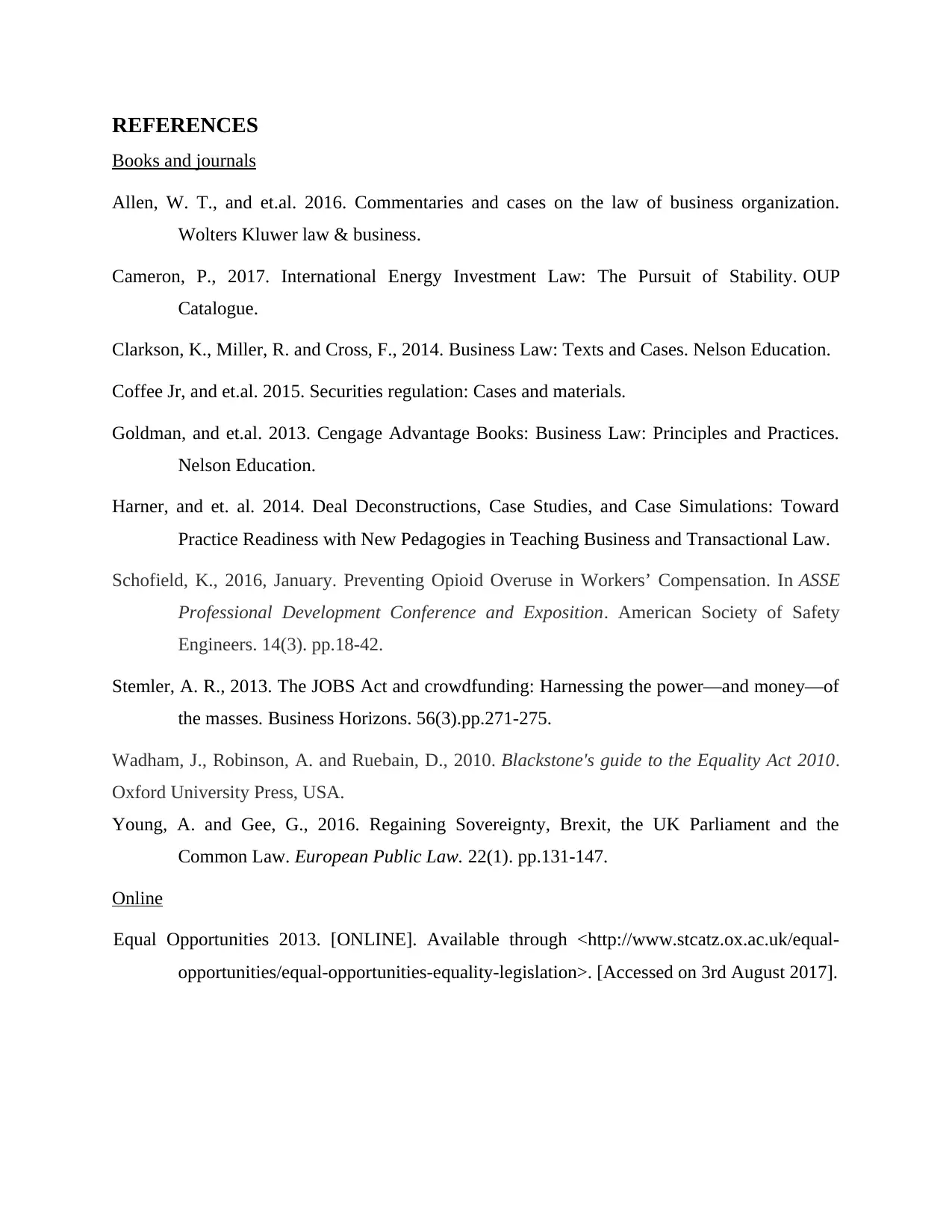
REFERENCES
Books and journals
Allen, W. T., and et.al. 2016. Commentaries and cases on the law of business organization.
Wolters Kluwer law & business.
Cameron, P., 2017. International Energy Investment Law: The Pursuit of Stability. OUP
Catalogue.
Clarkson, K., Miller, R. and Cross, F., 2014. Business Law: Texts and Cases. Nelson Education.
Coffee Jr, and et.al. 2015. Securities regulation: Cases and materials.
Goldman, and et.al. 2013. Cengage Advantage Books: Business Law: Principles and Practices.
Nelson Education.
Harner, and et. al. 2014. Deal Deconstructions, Case Studies, and Case Simulations: Toward
Practice Readiness with New Pedagogies in Teaching Business and Transactional Law.
Schofield, K., 2016, January. Preventing Opioid Overuse in Workers’ Compensation. In ASSE
Professional Development Conference and Exposition. American Society of Safety
Engineers. 14(3). pp.18-42.
Stemler, A. R., 2013. The JOBS Act and crowdfunding: Harnessing the power—and money—of
the masses. Business Horizons. 56(3).pp.271-275.
Wadham, J., Robinson, A. and Ruebain, D., 2010. Blackstone's guide to the Equality Act 2010.
Oxford University Press, USA.
Young, A. and Gee, G., 2016. Regaining Sovereignty, Brexit, the UK Parliament and the
Common Law. European Public Law. 22(1). pp.131-147.
Online
Equal Opportunities 2013. [ONLINE]. Available through <http://www.stcatz.ox.ac.uk/equal-
opportunities/equal-opportunities-equality-legislation>. [Accessed on 3rd August 2017].
Books and journals
Allen, W. T., and et.al. 2016. Commentaries and cases on the law of business organization.
Wolters Kluwer law & business.
Cameron, P., 2017. International Energy Investment Law: The Pursuit of Stability. OUP
Catalogue.
Clarkson, K., Miller, R. and Cross, F., 2014. Business Law: Texts and Cases. Nelson Education.
Coffee Jr, and et.al. 2015. Securities regulation: Cases and materials.
Goldman, and et.al. 2013. Cengage Advantage Books: Business Law: Principles and Practices.
Nelson Education.
Harner, and et. al. 2014. Deal Deconstructions, Case Studies, and Case Simulations: Toward
Practice Readiness with New Pedagogies in Teaching Business and Transactional Law.
Schofield, K., 2016, January. Preventing Opioid Overuse in Workers’ Compensation. In ASSE
Professional Development Conference and Exposition. American Society of Safety
Engineers. 14(3). pp.18-42.
Stemler, A. R., 2013. The JOBS Act and crowdfunding: Harnessing the power—and money—of
the masses. Business Horizons. 56(3).pp.271-275.
Wadham, J., Robinson, A. and Ruebain, D., 2010. Blackstone's guide to the Equality Act 2010.
Oxford University Press, USA.
Young, A. and Gee, G., 2016. Regaining Sovereignty, Brexit, the UK Parliament and the
Common Law. European Public Law. 22(1). pp.131-147.
Online
Equal Opportunities 2013. [ONLINE]. Available through <http://www.stcatz.ox.ac.uk/equal-
opportunities/equal-opportunities-equality-legislation>. [Accessed on 3rd August 2017].
1 out of 10
Related Documents
Your All-in-One AI-Powered Toolkit for Academic Success.
+13062052269
info@desklib.com
Available 24*7 on WhatsApp / Email
![[object Object]](/_next/static/media/star-bottom.7253800d.svg)
Unlock your academic potential
Copyright © 2020–2025 A2Z Services. All Rights Reserved. Developed and managed by ZUCOL.





